#geolocation tool
Explore tagged Tumblr posts
Link
Bulk GEO IP Locator - Find Geolocation Data for Multiple IPs
#ip checker#ip locator#geo ip#bulk IP addresses#Bulk GEO IP Locator#geolocation data#multiple IPs#IP lookup#geolocation tool#IP geolocation#IP address location
0 notes
Photo

Hinge presents an anthology of love stories almost never told. Read more on https://no-ordinary-love.co
339 notes
·
View notes
Text
This comprehensive guide is your roadmap to conquering the global digital landscape through effective international SEO strategies. Whether you're a multinational corporation or a growing startup with global ambitions, this guide provides invaluable insights into leveraging SEO to expand your reach, connect with international audiences, and achieve online success.
#International SEO#Multilingual SEO#Global SEO strategies#International keyword research#International SEO best practices#Hreflang tags#Geolocation SEO#International content optimization#International link building#Global SEO for e-commerce#Local SEO for global websites#International SEO analytics#International SEO tools
1 note
·
View note
Text
Useful (not AI) Tools for Writing
For years I've been compiling a list of useful tools for writing (fiction and non-fiction) and I thought it might be fun to share it.
What am I missing? What do you use and love? I'd love to keep building this list!
Historical Research
General plug: Librarians!!! They want to help you.
Search for words/signs in Brooklyn
Encyclopedia of Hair
Underwear, a history
Newspapers.com
Historical (and modern) meeting minutes
Find a grave
Political TV Ad archive
Oral Histories
Columbia
National Archives
MoMA
Archives of American Art
The Oral History Review
Words
Wordnik
Dictionary of American Regional English
Scrivener built in name generator
Lose the very
Scene Setting / Images
Animals & Plants by geolocation (also good for general scene setting)
Flickr world map
Past weather by zip code
Google Maps streetview / Google Earth
General Inspiration
Oblique Strategies
Worldbuilding
Tarot decks (my personal favorite is this one)
The Thing from the Future
The Picture Game
Misc
Data is Plural -- a newsletter full of interesting datasets
#writing#resources#writing resources#fiction writing#non-fiction writing#finding stuff#librarians are the best people in the world#archives#historical research#you don't need AI to help you write
195 notes
·
View notes
Text
Belarusian Man Constructs and Sets Sail in a Boat Made Entirely of Ice

Ivan Karpitsky, a Minsk resident, is well-known in Belarus for his passion for ice and snow sculptures. His name first made headlines in 2020 when photos of his ice violin went viral on social media. Since then, he has kept himself busy each winter with increasingly ambitious projects, but this year he truly outdid himself with a stunning and functional boat made entirely of ice.
Photos and videos shared on his Instagram page show Karpitsky meticulously carving and chiseling blocks of ice to create his impressive masterpiece, showcasing his remarkable dedication and skill.

Little technical information is available about Ivan's ice boat, aside from what can be seen in the photos and videos he has shared on social media. According to geolocation data, the boat was built along the shores of Tsnyanskoe Reservoir, an artificial lake north of Minsk near the former village of Tsna-Yodkovo.
In the footage, the artist is shown cutting rectangular blocks of ice and bonding them together with water. He then chisels the frozen surface of the lake to carve out the base of the boat, demonstrating his resourcefulness and ingenuity.

Karpitsky employed a variety of power tools to craft intricate ice panels, which he carefully slid between the larger ice blocks. He also created a rotating ice rudder that, while non-functional in steering the vessel, adds a significant aesthetic appeal. Additionally, the artist designed two detachable paddle wheels that can be mounted at the back of the boat and connected to a land-based power source to create the illusion of propulsion.
The Belarusian’s ice boat has gone viral on social media, drawing widespread attention. Karpitsky has already been inundated with requests for custom-made ephemeral creations similar to his ice boat. However, the self-taught artist has so far declined all such commissions.
23 notes
·
View notes
Text
President Trump and his former star advisor, Elon Musk, have accelerated the deployment of a vast technological infrastructure that monitors the lives of millions of people. The system is focusing on immigrants — for now Massive unauthorized scanning of social media. Analysis of biometric, income, health, and Social Security data. Interception of telephone communications. Geolocation via mobile devices. Tracking of car journeys using license plate readers. Since Donald Trump returned to the White House, the U.S. government has been using these and other tools based on artificial intelligence (AI) to monitor and persecute thousands of people without judicial authorization — mostly immigrants, foreigners passing through, or students. In the last four months, Trump and his former star advisor, the tech tycoon Elon Musk, have, along with the private sector, accelerated the deployment of a massive techno-surveillance state. And for the first time in history, Washington is boasting about it rather than denying its existence. “Surveillance in the U.S. didn’t begin with Trump, nor will it end when he leaves the White House. The foundations for the current state of techno-surveillance were laid over decades, with bipartisan support for policies that normalized invasive practices in law enforcement, the military, and border control,” says the Bahraini civil rights activist Esra’a Al Shafei, who has been studying this issue for years, in a conversation with EL PAÍS. “This system is fueled by large budgets allocated to intelligence agencies, as well as private providers, all under the pretext of national security and crime prevention.” Companies like Palantir, Anduril, and GEO Group are providing Washington with digital tools to build this entire surveillance infrastructure. Trump continues to add layers to this system. The Department of Homeland Security (DHS) confirmed in April that it is using a tool called Babel X to collect social media information about travelers who may be subject to increased surveillance, according to the agency itself. Immigration and Customs Enforcement (ICE), for its part, has acknowledged using another program, SocialNet, which aggregates data from more than 200 sources, including Facebook, Twitter/X, Instagram, LinkedIn, and dating apps.
continue reading
6 notes
·
View notes
Text
youtube
Digital innovations can elevate citizen science as an internationally recognized source of data used by policymakers and as a career opportunity for young people
The Enviro-Champs are a group of over a thousand people using citizen science to draw attention to water quality issues in South Africa.
“We work with the Enviro-Champs to support us on the ground to collect data on rivers”, said Futhi Vilakazi of uMngeni-uThukela Water.
Research by scientists at the International Water Management Institute (IWMI) and GroundTruth have shown that simple visual tools such as charts to identify and count lifeforms in rivers, or acrylic tubes to identify the clarity of water, can provide comparable results to laboratory tests.
Groups like the Enviro-Champs and other citizen scientists have readily adopted these tools, demonstrating the unique contribution that can come from co-engaged local communities. Citizen scientists can collect more data over longer periods, across large regions or with greater intensity. In one study*, volunteers monitored how water pollution from wastewater treatment works varied every day between 2012 and 2019. Less than two years after the treatment plant was made aware of this monitoring, their compliance with regulations shot up from zero to 60-70%.
Nonetheless, citizen science comes with its own challenges. The process remains highly manual and often paper-based, relying on the selfless dedication of volunteers to improve local issues. Although the community aspect can be a powerful motivator to local authorities, the data they collect are often seen as being too unreliable to use for management.
Through the CGIAR Initiative on Digital Innovation, IWMI, Groundtruth and key local partners are collaborating to develop technological upgrades that can transform the impact of citizen science.
This includes a smartphone app to digitize, geolocate and upload citizen science river health surveys, using the mini stream assessment scoring system (miniSASS), to an online platform. There have been >350 river health surveys submitted by citizen scientists in 2024. An image recognition AI function was created to recognize lifeforms in the river that indicate water quality, helping verify the data in real time.
#solarpunk#solar punk#community#indigenous knowledge#africa#jua kali solarpunk#citizen science#digital innovation#apps#smartphones#science#Youtube
7 notes
·
View notes
Text
I like the DC x DP AUs where the Justice League and Amity Park (and Elmerton by proxy) never noticed each other due to an information blackout. I also find it neat when the idea's taken a step further.
For example, what if the government built Amity Park on insanely haunted land on purpose? Let's say, years ago, the whole LoA and Ra's Al Ghul situation made the U.S government curious about Lazarus water. They wished to find it's source in order to harvest it themselves.
The U.S preferred to avoid Lazarus pools that already existed to prevent conflict with the LoA. Instead, they decided to seek out the perfect location to "dig a well" of their own.
GIW scientists established that Lazarus water, a heavily condensed version of ectoplasm, was linked to ghosts and other ectoplasmic entities. They also observed that these entities are highly attracted to human populated areas.
This gave them the idea to settle a whole population of people on a liminal hotspot to lure ecto entities into the human realm. With the Anti Ecto Acts in place, the GIW were be free to capture ghosts and other creatures for their ectoplasm. The end goal was for the Fenton portal to be used as a well to harvest mass quantities of ectoplasm directly from the Infinite Realms.
How might this work for Amity Park and it's place in the world?
The information blackout is heavier outside the Amity-Elmerton territory than inside. Amity residents are only cut off from info that could threaten the government project (EX: the existence of real life superheroes, the Meta Protection Acts, certain major events, etc.).
All devices that enter the Amity-Elmerton territory are unable to send or receive video/pics of the above "blocked" topics. In fact, it's difficult for social media users within that territory to connect with any posts or profiles from outside unless they look hard enough.
Amity residents are still allowed to travel, but airline ticket prices are jacked ridiculously high, especially for specific destinations (i.e: common superhero locations) to deter those residents from going there. GPS devices and maps bought in Amity or Elmerton are also set to misdirect users away from these same locations if they opt for a road trip.
Most Amity-Elmerton residents hardly bother leaving at all since there's a hefty fee for crossing beyond a set perimeter. They've all been lead to believe this is a normal part of traveling in the Midwest.
To everyone outside the Amity-Elmerton area, that area is virtually non-existent. It's not listed on any map, globe, or basically any public geolocation tool outside those provided in Amity (not even Google Maps). The only hints of it existing are in certain forms of documentation, such as birth certificates and tax forms. Even then, these people are hard to come by.
At most, Amity Park is a little known myth where people occasionally debate on it's existence.
In general, the government limiting Amity-Elmerton residents access to outside info while giving them just enough to stave off suspicion.
#dc x dp#headcanon#au#danny phantom#dc universe#This may or may not change later#It's a spur of the moment brain dump#I just like Danny being flabbergasted that superheros and aliens exist#meanwhile the JL are equally flabbergasted that someone can still be out of the loop after all the world ending catastrophies they prevented#Upon first meeting they're like “This meta kid doesn't even know what a meta is”#And then later Danny and a JL member compare maps and notice some glaring inconsistencies that just complicate everything#I wonder how long it'd take them to rule out alternate dimensional travel
84 notes
·
View notes
Text
Violet Miller at Chicago Sun-Times:
In the wake of President-elect Donald Trump’s reelection, advocates for transgender people in Illinois are scrambling to strengthen the state protections they’ve created, while some trans Midwesterners consider moving to states with shield laws for safe harbor. State Rep. Kelly Cassidy told the Sun-Times there has been a coalition effort of state lawmakers to protect trans and reproductive health care access since the U.S. Supreme Court’s decision to overturn Roe v. Wade leaked in 2022. Now, they’re looking closely at Project 2025 — a conservative policy playbook created by the Heritage Foundation — and Trump policy proposals and “evaluating what further protections we can enact in the coming months,” a spokesperson for Gov. JB Pritzker said. One gap the coalition identified is medical data privacy and the use of geolocators to track people who visit health care facilities, which Cassidy said she’s confident will be fixed before the fall legislative session ends. “There’s a hole in that [legislative] shield, and that’s data privacy, so that’s the top priority,” Cassidy said.
Protections for reproductive rights and gender-affirming care were enshrined in state law in January 2023, putting Illinois on the side of people who risk prosecution by traveling to the state for treatment and also protecting the licenses of Illinois doctors who provide care that’s illegal elsewhere. The Illinois Human Rights Act also protects against discrimination based on gender identity. In July, the Legislature gave Illinois judges the tools to help people change their names and gender markers on out-of-state documents. But many of the threats made by Agenda47, the Trump campaign’s outline for the next four years, and Project 2025 would undermine these by circumventing existing protections.
“If a national ban [on gender-affirming care] passed, that’s our worst-case scenario,” Cassidy told the Sun-Times on Friday. “None of our laws will matter.” The documents outline plans to end civil rights protections for LGBTQ+ people, remove doctors who provide gender-affirming care from Medicare and Medicaid coverage, and withhold funds from schools that protect the rights of trans students, among other things.
[...] Fourteen states and Washington, D.C., have shield laws for gender-affirming care, though Minnesota and Illinois are the sole havens for displaced trans people in the Midwest.
With Donald Trump's victory and the toxic Project 2025 and Agenda 47 looming, Illinois is seeking to further strengthen protections for trans people, and that trans people residing in anti-trans states such as Missouri and Indiana are seeking safe harbor from attacks on their identity and expression by moving to Illinois.
#Illinois#Transgender Safe Refuge#Transgender Rights#Transgender#J.B. Pritzker#Kelly Cassidy#Illinois Politics#Agenda 47#Project 2025#LGBTQ+#Gender Affirming Healthcare#Shield Laws
8 notes
·
View notes
Text

I've got nothing to post right now so have my oc, hes part of a subdivision of smaller iterators (in the sense of robot-like creatures) able to think of themselves (but are mobile) aka Operators :D
more rambling about Operators below :)
Operators serve as a way to persue small tasks between closeby groups, created during gen 2 of Iterators they serve as a ''fix it all'' having a set manual encoded in them which provides them with the necessary tools to fend for themselves and geolocate closeby structures which provide energy.
Being off the strings for them it means that they function off few neurons which they carry inside their body (which keeps them alive and stores some necessary stuff + recently given commands + records important events during their travels from one facility to the other). They recharge via a chargeble battery installed in their system by connecting it to anything remotely mechanical, such as shelters, karma gates (which they are able to access unless theyre karmically imbalanced or arent given permission to), communication stations/arrays and so on.
They do not have a great memory, they work on a limited one when off-field and when they reach the closest iterator they will connect to their structure, offering a scan of their can and offering to solve any issues they are able to fix within it, but most important they will empty their memory (think of outside storage) in order to recieve a new command/order/task. Their main purpose is to serve under the rules of the ancients and help with upkeeping iterator groups local to them or following their orders which may change from anything such as pearl collection, transferring data, rearranging faulty memory conflux structures, eliminate any threatening bodies to their host iterator can and so on!
[cough, if they find mobile rot even if their host iterator tells them not to kill it they will go on the violent route to eliminate the rot or mold]
Greatly respectful of ancients and senior iterators they will greatly follow orders given by seniors and other iterators, doing small tasks for them and serving low range messenger/support friend if you will. They are shorter than most iterators (with my guy being shorter than five pebbles) but more resistant and resilient than the mid iterator puppet plus a lot stronger!
Usually theres anywhere between none to five in groups, depending on their size and how old they are.
IDK they have some sort of weapon which they probably either carry around or its part of their design, mine has claws.
Their main rules are:
-follow iterator wishes
-ensue their safety
-dont mess with the enviroment (less prone to violence towards organic creatures)
ABOUT MY OC TE HEE
Ordinary Maintenances is under Chronicler of Methologies (an archivist iterator which belongs to @nemofil and they work under pearl collection duty most of the time, why most of the time?
Scavengers think of Ordinary Maintenance as a very very shiny object, so they trade him around until he menages to actually get up and leave their premises which is sadly not that successful. Seeing as Chronicler is quite a pacifist and feel bad about Scavenger he will often do nothing (not as he can do it) about it, leaving often time OM being traded around for shiny stuff.
Im not sure how i wanna kill them off but oh well, hes quite the resistant one, surviving through an iterator attacking them, being a chewtoy sometimes on sundays, and witnessing some pretty violent scav conflicts hes quite the silliest :)
stay in pieces chronicler, may you be loved by him as yk bros do (/j)
86 notes
·
View notes
Text
Engineering Development Group-CIA malware and hacking tools are built by EDG (Engineering Development Group), a software development group within CCI (Center for Cyber Intelligence), a department belonging to the CIA's DDI (Directorate for Digital Innovation). The DDI is one of the five major directorates of the CIA. The EDG is responsible for the development, testing and operational support of all backdoors, exploits, malicious payloads, trojans, viruses and any other kind of malware used by the CIA in its covert operations world-wide. The increasing sophistication of surveillance techniques has drawn comparisons with George Orwell's 1984, but "Weeping Angel", developed by the CIA's Embedded Devices Branch (EDB), which infests smart TVs, transforming them into covert microphones, is surely its most emblematic realization. The attack against Samsung smart TVs was developed in cooperation with the United Kingdom's MI5/BTSS. After infestation, Weeping Angel places the target TV in a 'Fake-Off' mode, so that the owner falsely believes the TV is off when it is on. In 'Fake-Off' mode the TV operates as a bug, recording conversations in the room and sending them over the Internet to a covert CIA server. As of October 2014 the CIA was also looking at infecting the vehicle control systems used by modern cars and trucks. The purpose of such control is not specified, but it would permit the CIA to engage in nearly undetectable assassinations. The CIA's Mobile Devices Branch (MDB) developed numerous attacks to remotely hack and control popular smartphones. Infected phones can be instructed to send the CIA the user's geolocation, audio and text communications as well as covertly activate the phone's camera and microphone. These techniques permit the CIA to bypass the encryption of WhatsApp, Signal, Telegram, Wiebo, Confide and Cloackman by hacking the "smart" phones that they run on and collecting audio and message traffic before encryption is applied.
2 notes
·
View notes
Text
if there's anything that AI has really helped me with (apart from wasting huge amounts of water), it's with basically selling the concept of me as an employable person.
I rarely use AI outside of work and I don't use it to generate images. But what I've asked it to do is to try and write summaries and cover letters because there are a billion fucking jobs out there and it's so fucking dire. I really can't stand trying to apply for 20 jobs per month after hours of draining work only to have no one fucking call back.
And it's doing a better job at projecting this confident version of myself, this confident Ellis, than I am. In effect I have to water down what it says 90% of the time (as a sensible writer I do not fucking copy and paste what it says)
read this part of the biography that i asked it to write for my muckrack profile which i eventually omitted:
Throughout my career, I've developed a specialised toolkit that includes verification techniques, geolocation, chronolocation, and various technical platforms like Google Earth, Baidu Maps, and SunCalc. I'm also proficient in media monitoring tools including X Pro (formerly TweetDeck), Weibo, CrowdTangle, FlightRadar24, and MarineTraffic.
This is such a fucking lie lol. All I did was to spend like two weekends putting together geolocation quizzes for the new folk joining my team, and that was. what. four years ago. crowdtangle is also dead, so selling that seems so weird. (FUCK meta.)
but yeah you gotta sell yourself, your brain and your body, so...
4 notes
·
View notes
Text
Trafficshield Review: What You Should Know Before Deciding
If you’re exploring cloaking tools, there’s a good chance you’ve heard of Trafficshield.io — and maybe even seen some heated opinions online.
One thread on a popular forum straight-up says: “Avoid Trafficshield. Not worth the risk.” That kind of post makes you pause. I’ve been there — wondering if I’m about to waste money or nuke a campaign. So, I decided to share my experience. I’ve actually used Trafficshield in real campaigns, and I think a more balanced review is long overdue.
What is Trafficshield, Really?
At its core, Trafficshield is a cloaker. You set the rules, and it filters traffic accordingly. Simple as that.
It checks for stuff like:
IP ranges
Geolocation
Language headers
Device types
ASNs …and then either lets users see your offer or shows them a fallback page.
Basically, if you’re trying to keep ad reviewers or bots out of your funnels, this tool helps with that.
I’ve used it in campaigns where the offer wouldn’t exactly pass a manual review. You get what I mean. It’s built for affiliates who are running high-risk funnels or geo-sensitive offers. If you need to cloak, it gets the job done.
How Trafficshield Performed for Me
I am using it since last year and run several campaigns. Here’s how it stacked up.

Setup
Getting started was easier than I expected. I added a script to my landers, set up a few rules, and traffic started flowing. No DNS headaches. Just clean and quick.
The dashboard? Not fancy, but it works. Logs update in real-time, and you can see what’s being filtered and why.
Filtering Quality
The engine behind this thing is solid. It filtered out junk IPs and known bot ranges better than another cloaker I’d been using. One of my campaigns was running heavy EU traffic, and it handled that better than expected.
Support
I had a couple of questions early on. Their support replied in under an hour. That’s rare in this space. The docs aren’t super detailed, but they’re enough to get you going.
One Glitch (User Error)
There was one case where my rule didn’t fire correctly, and a few reviewers slipped through. Turned out I’d set up the wrong header filter. Once I fixed that, everything ran smoothly again. So yeah, double-check your rules.
What About the Hate?
I saw the same thread you probably did — the one trashing Trafficshield. Here’s my honest take:
Most people slamming cloakers either didn’t configure things properly or had wild expectations. No cloaker is magic. You still need to understand traffic sources, reviewer patterns, and how to write decent rules.
And let’s be real — sometimes the loudest complaints come from people pushing a competing tool. That’s just how this game works.
Final Thoughts
So, is Trafficshield worth it?
For me, yes. It did what I needed: filtered out bad visits, protected my campaigns, and gave me a decent level of control. Is it perfect? Nope. But if you’ve worked with cloakers before, you’ll appreciate the simplicity and speed.
If you’re just starting out and expect it to save a badly built funnel — good luck. But if you know what you’re doing, Trafficshield.io is a tool worth testing.
2 notes
·
View notes
Text

Kostia Hornain Debain, from the series 'Contre-Courant', KG+ 2025
Contre-Courant, récit d’un retour aux sources
“I was born in Ukraine and spent a year in an orphanage in the city of Donetsk before being adopted by my French parents. I grew up in Paris. At the age of 20, I felt a deep need to return to my country of birth, to reconnect with my roots. But very shortly after, in February 2022, the war in Ukraine changed everything. Today, I feel like I’m going against the current.”
he decided to make the journey anyway, tracing the path in reverse from the one he took more than twenty years ago. The trip begins in Kyiv, the city he departed from to go to France, passes through Donetsk, where the orphanage was, and ends in Sejnoia, his birthplace.
It’s a spatial wandering, but also a temporal one, since the images he sees on his screen — which allow him to discover these cities — are of uncertain dates. This temporal blur appeals to him: he navigates between fiction and reality — his own imagined narrative projected onto these still-unknown places, and a tangible reality made accessible through the precision of geolocation tools.
To these images, he adds poignant accounts from Ukrainian refugees in France. These testimonies act as interludes — sudden returns to the present, as if this intimate quest also ran counter to the stream of current world events. Though one might come across a tank in a street, much of the imagery consists of landscapes, people in motion… almost like street photography evolving according to each city.
2 notes
·
View notes
Text
GIS In Our Daily Lives
The involvement of Geographic Information Systems (GIS) in our daily lives is pervasive, influencing and enhancing various aspects across different sectors. The integration of GIS into everyday activities has become integral for decision-making, planning, and optimizing resources. GIS helps city planners and transportation experts to provide them with information like maps, satellite pictures, population statistics, and infrastructure data. GIS helps them make better decisions when designing cities and transportation systems that are sustainable and good for the environment.
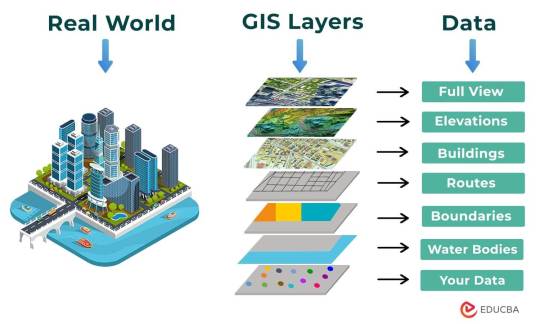
The following points elucidate the notable involvement of GIS in our daily lives:
Navigation and Location Services: GIS provides monitoring functions through the visual display of spatial data and precise geographical positioning of monitored vehicles, whereas GPS provides accurate, clear, and precise information on the position and navigation of a monitored or tracked vehicle in real-time and at the exact location.GIS is at the core of navigation applications and location-based services on smartphones. It enables accurate mapping, real-time navigation, and geolocation services, assisting individuals in finding locations, planning routes, and navigating unfamiliar areas.
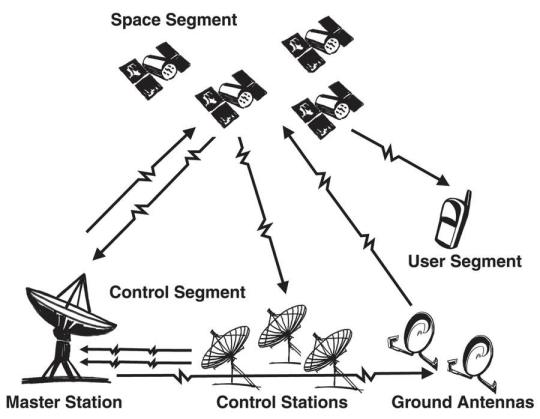
E-Commerce and Delivery Services: GIS software is a powerful tool for supply chain network planning. It helps determine the optimal location for distribution centers, warehouses, or other supply facilities. GIS is utilized in logistics and delivery services for optimizing routes, tracking shipments, and ensuring timely deliveries. E-commerce platforms leverage GIS to enhance the efficiency of their supply chain and last-mile delivery processes.
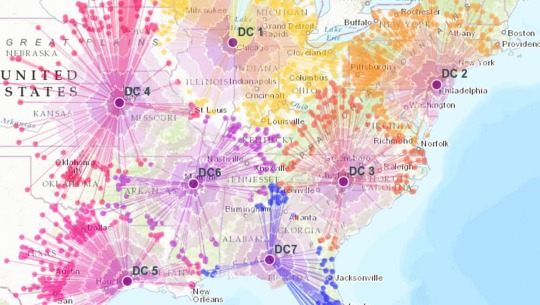
Weather Forecasting and Disaster Management: Many states are using GIS dashboard to monitor the rainfall across the state, on a real-time basis, from the data shared by rain sensors installed at various locationsGIS plays a crucial role in weather forecasting and disaster management. It assists meteorologists in analyzing spatial data, predicting weather patterns, and facilitating timely responses to natural disasters by mapping affected areas and coordinating emergency services.
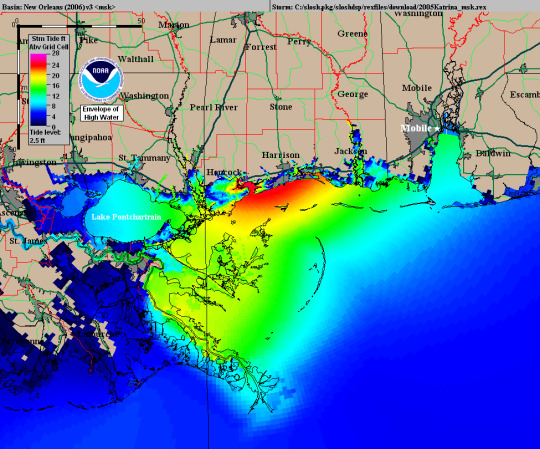
Healthcare Planning and Disease Monitoring: Geographic Information Systems enable the visualization and monitoring of infectious diseases. Additionally GIS records and displays the necessary information that health care needs of the community as well as the available resources and materials. GIS supports public health initiatives by mapping the spread of diseases, analyzing healthcare resource distribution, and assisting in the planning of vaccination campaigns. It aids in identifying high-risk areas and optimizing healthcare service delivery.
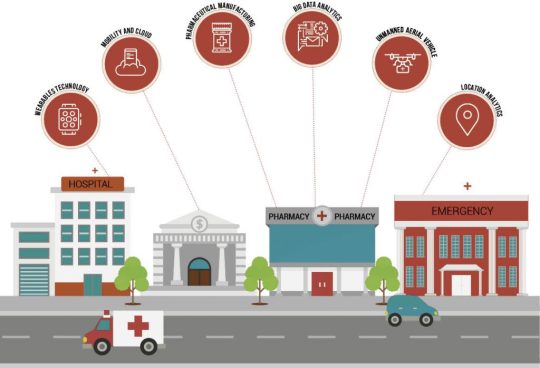
Social Media and Geo-tagging: GIS also helps in geotagging and other location related information in posts, it’s tools can map and visualize the spatial distribution of social media activity. This analysis can reveal trends, hotspots, and patterns in user engagement across different geographic areas. Many social media platforms incorporate GIS for geo-tagging, allowing users to share their location and experiences. This feature enhances social connectivity and facilitates the sharing of location-specific information.
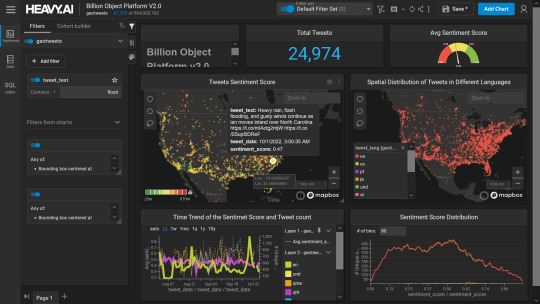
Smart City Initiatives: The Geographic Information System (GIS) offers advanced and user-friendly capabilities for Smart City projects and allows to capture, store and manipulate, analyze and visualize spatially referenced data. It is used for spatial analysis and modeling. It is the cornerstone of smart city planning, enabling the integration of data for efficient urban management. It supports initiatives related to traffic management, waste disposal, energy consumption, and overall infrastructure development.

Education and Research: GIS is increasingly utilized in education and research for visualizing and analyzing spatial data. It enables students and researchers to explore geographic relationships, conduct field studies, and enhance their understanding of various subjects.

Agricultural Management and Precision Farming: Farmers leverage GIS to optimize agricultural practices by analyzing soil conditions, crop health, and weather patterns. Precision farming techniques, facilitated by GIS, contribute to increased crop yields and sustainable farming practices.
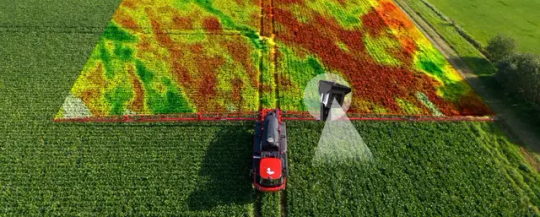
Real Estate and Property Management: In the real estate sector, GIS aids in property mapping, land valuation, and site selection. It provides real estate professionals with valuable insights into spatial relationships, market trends, and optimal development opportunities.
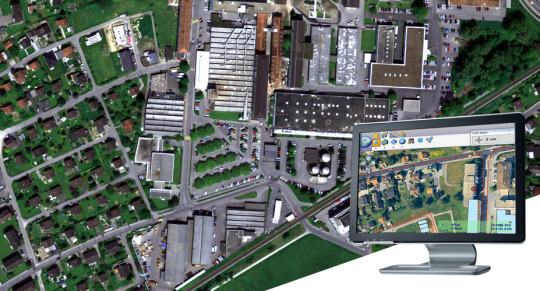
Tourism and Recreation: GIS enhances the tourism industry by providing interactive maps, route planning, and location-based information. It assists tourists in exploring destinations, finding attractions, and navigating efficiently.
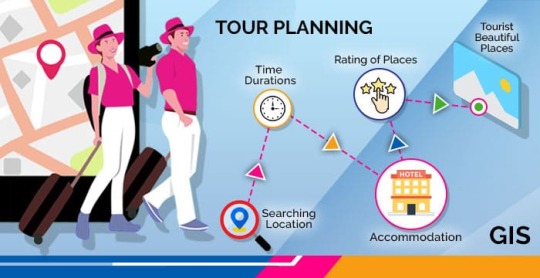
The broad and varied involvement of GIS in our daily lives underscores its significance as a technology that not only facilitates geographic data analysis but also contributes to the efficiency, safety, and interconnectedness of modern society. As GIS applications continue to evolve, their impact on daily activities is expected to further expand and refine.
#gis#architectdesign#architecture#city#education#geographic information system(gis)#geographical indication
14 notes
·
View notes
Photo

Hinge presents an anthology of love stories almost never told. Read more on https://no-ordinary-love.co
229 notes
·
View notes